
June 2021 Edition

By Neetu Sadhwani
Share
The pedagogy of Language Learning and the importance of instruction in MFL
The role of the language teacher in today’s classroom has shifted from being the expert to that of facilitator or guide with the mission of supporting students to become confident linguists by developing listening, speaking, reading and writing skills in that language, as well as enhancing their curiosity for the language and its culture.
In 2012, Barack Rosenshine published the Principles of Instruction: a set of 10 research-based principles of instruction, along with suggestions for effective classroom practice. These principles can help Modern Foreign Language teachers direct their planning and methodologies in order to achieve best levels of progress and outcomes from students. Below an example on how I have applied them to teach students how to describe a photo card, a task all language GCSE students complete during their speaking exam.
Principle 1) Begin a lesson with a short review of previous learning:
Before introducing the first question in a photo card- ‘What can you see in the photo?’ students would need reminding and revisiting of simple KS3 sentences such as ‘there is/there are’ or the present tense to describe people physically. Easy and effective ways to do this are via simple activities such as filling in the blanks or matching up English words and sentences with the equivalent French or Spanish.
Principle 2) Present new material in small steps with student practice after each step:
Once students have revisited previous knowledge that can be used for the photo card task, I present the class with their first exam photo card like the one below, by breaking down the requirements of the questions, in order to help them reduce the cognitive load. For example, to answer the first question ‘¿Que hay en la foto?- (what is there in the picture?), it is common language practice to use the acronym PALM W (People, action, location, mood, weather). Instead of presenting the acronym at once, I would teach them simple grammatical sentences for each of the elements in the acronym individually first, which will help students get to the whole description in smaller steps.

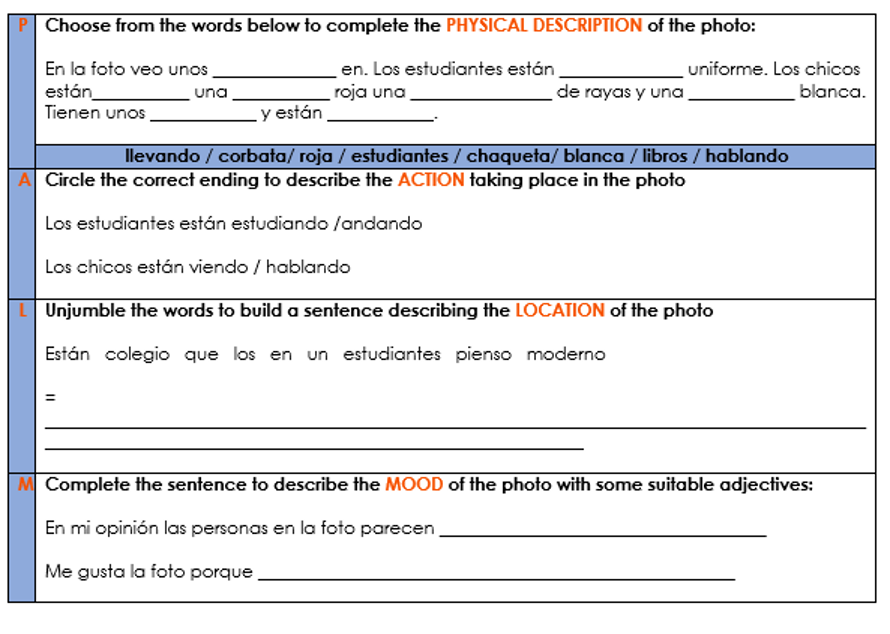
Principle 3) Ask a large number of questions and check the responses of all students:
When students are confident answering the first question, I present them with a number of questions to forecast what the other four questions on this card could be and which verb tenses would they require?
Principle 4) Provide models:
In order to support students answering the rest of the questions, which involve responses in different tenses (present, past or future) as well as a higher level of development in their language structures, I apply Rosenshine’s principle by modelling A* answers. This can be done by pairing a set of questions and answers on a power point, and then highlighting the elements that make the model answers so highly rated by examiners.
Principle 5) Guide student practice:
Students have the full photo card with all five questions in the target language and can now carefully plan written answers with feedback from me or from their peers. This helps them gain the opportunity to focus on the area that needs practice, for example a particular verb tense.
Principle 6. Check for student understanding:
Once students have produced well-guided and developed answers for all questions, I would collect them in to check that accuracy, grammar and content is correct and that no misconceptions have occurred.
Principle 7) Obtain a high success rate:
One way to do this is by adding a fun element of competition and rewarding the most developed or most original answers for this photo card.
Principle 8) Provide scaffolds for difficult tasks: The teacher provides students with temporary supports and scaffolds to assist them when they learn difficult tasks.
On the following lesson, students are presented with a new exam photo card. Before asking students to start drafting their own answers, I play a recording of an A* candidate performing the exam task and present them with a partial copy of the transcript, where they listen and fill in the gaps before creating their own responses.
Principle 9) Require and monitor independent practice:
After all the above, regularly presenting students with photo cards during classwork or homework will allow them to produce more independent, differentiated and creative responses.
Principle 10). Engage students in weekly and monthly review:
The photo card, once introduced and practised, should then become part of students’ regular class and assessment practise.
The essence of Rosenshine’s principles allows language teachers to ensure their lesson planning supports students achieve their desired goals in a language classroom by regularly reviewing, modelling and practising language skills.
Sources:
Rosenshine B (2012) Principles of Instruction: Research-Based Strategies That All Teachers Should Know. American Educator 36(1): 12–19/39. Available at: https://www.aft.org/sites/default/files/periodicals/Rosenshine.pdf (accessed 12 April 2019).
Rosenshine B and Meister C (1992) The Use of Scaffolds for Teaching Higher-Level Cognitive Strategies. Available at: https://www.ascd.org/ASCD/pdf/journals/ed_lead/el_199204_rosenshine.pdf (accessed 30 June 2019).
https://earlycareer.chartered.college/applying-rosenshine-to-the-mfl-classroom/
https://frenchteachernet.blogspot.com/2019/06/the-rosenshine-principles-applied-to-mfl.html

June 2021 Edition

By Shaveta Julka
Share
Feedforward AfL
Moving to a remote setting proved to be challenging for many in education, whether you were a parent, pupil or staff member. One of the largest barriers to overcome was Assessment for Learning (AfL).
In September 2020 there was a movement to change the way in which homework was set in Science, which was to include the use of feedforward assessments. This stands as one of the ways that many subject areas have chosen to adapt their practice by turning short term Covid-19 solutions into long-term evolutions. Shaveta not only shared in the pioneering of this approach, but she also decided to work on measuring the success of this new AfL strategy which included Google Forms, as shown in Figure 1.[1]

Figure 1- Google Forms can be accessed via multiple platforms
Feedforward assessments are multiple-choice tests that, upon completion, are automatically assessed. The questions were not stereotypically easy. Using different exam boards, challenging questions that sometimes ask the pupil to identify which is the least correct response. Often, they involve multiple step calculations that would normally otherwise be broken down in a standard GCSE paper. This way the effective nature of the test is not ruined by the multiple-choice format, as discussed by Christodoulou in her research on multiple choice questions.[1]
The intent of the Science team was that reflection and progress would be made during the preparation before as well as after they completed the test. Once a pupil submits their test they not only receive a score, but they also have the opportunity to work on specific areas in which they did not perform. To create this opportunity, the teachers added weblinks for all questions such that when a pupil submits an incorrect answer, the link is shared for them to take control of their own learning pathways and work towards mastery independently. This increases the chance of pupils reaching a level of self-regulation[2] as shown in Figure 2 (Hattie and Timperley, 2007).[3]
Shaveta’s investigatory approach was to measure the engagement and impact of these feedforward assessments from a pupil’s perspective. As mentioned previously, the lockdown had both personal and professional impacts on the way in which we work due to the different demands we were put under. It has shown that pupils can learn independently in many different ways outside, as Figure 3 suggests[4].

Figure 2 – Based on Hattie, J. and Timperley, H. – The power of feedback: Review of Educational Research, 77(1), 81 – 112 (2007)

Figure 3 – The lockdown has impacted the way in which pupils learn.
The implementation strategy was achieved through effective monitoring, support, scaffolding and shared ownership. Once feedforward became an integral part of the Science Assessment for Learning Policy, Shaveta asked pupils from the targeted year groups to complete a survey.

Figure 4 – Pie chart to show how well implemented the strategy was from leaders at all levels within the department.
Shaveta analysed the information, and she evaluated her initial intent as well as the way in which she implemented her RIS. From Figure 4, she explained, “I will ask all teachers to use Google Classroom as well as Arbor to set the assessment and complete the feedforward. We could download the excel sheet with feedforward opportunities for each pupil and discuss them at parents evening. Some teachers might not have set assessments this year in the usual timeline due to our Covid Curriculum.”

Figure 5 – Pie chart to indicate if pupils felt that feedforward has a positive impact on their learning.

Figure 6 – Bar chart to show how pupils evaluated the overall effectiveness of feedforward.
The Science department have truly created something that can truly be used again and again, though the weblinks may need to be updated for the feedforward opportunities. When reflecting on this, Shaveta also said, “During department time I would like the staff to work in pairs to update feedforward links based on suggestions from the pupils.”

Figure 7 – Pie chart to show the most effective formats used for feedforward.

Figure 8 – Pie chart to show the least effective formats used for feedforward.
The feedback from the final question in the survey which asked pupils to suggest improvements such as:
“To practise more exam style questions specific to a question in order for them to understand and improve their grades.”
“Different ways to tackle specific questions and giving step by step instructions on more difficult questions.”
“More teacher input/ going through some questions in detail during the lesson after they have completed the assessment.”
“Giving more revision time.”
The positive aspects of the survey show two main themes. Firstly, pupils found that more opportunities to practice their skills in specific areas was the most beneficial aspect of the feedforward. Secondly, the data suggests that YouTube is helpful to revisit content. Both are dependent on quality and relevance and could be unpicked further. This is yet another direction in which Shaveta’s Research Informed Strategy could take her.
When looking at multiple options, Shaveta has decided that a way to look at the impact this has on pupil outcomes may be the next step. At the moment, pupil perception suggests that Feedforward AfL is a positive experience. Could this format use the engaging advantages of gamification whilst still allowing progress to be rapid, sustained, and precise?
[1] Christodoulou , D. (October 2013) – Research on multiple choice questions – https://daisychristodoulou.com/2013/10/research-on-multiple-choice-questions/
[2] Newman, M. et al., EEF – The impact of Feedback Approaches on educational attainment in children and young people; Protocol for a Systematic Review: Post- Peer Review (December 2020) Pages 4 – 6 https://educationendowmentfoundation.org.uk/public/files/Publications/EEF_Systematic_Review_of_Feedback._M_Newman._Dec_2020b._Protocol.pdf
[3] Belle, A. – https://i.pinimg.com/originals/d9/42/a3/d942a326e627b58f6245f32d84bb0cf9.jpg
[4] https://kinsta.com/wp-content/uploads/2018/01/wordpress-lms-plugins-1-1024×512.png
[5] https://kinsta.com/wp-content/uploads/2018/01/wordpress-lms-plugins-1-1024×512.png

June 2021 Edition

By Natalija Skegro
Share
Leading with Rosenshine’s Principles
Rosenshine has become familiar to many of us in the profession, especially when looking at research-informed strategies that can enhance our practice. His work on the ‘Principles of Instruction’[1] is yet another example as to why our understanding of cognitive science and expert teaching is so important. Before Natalija joined Avanti, she had already immersed herself in Rosenshine’s findings and has looked forward to bringing them to the forefront of the minds of the teachers within our PRE Department.
Natalija recalled one of her first meetings with the team, which focused on outlining the intent and how this could tie into the Avanti Way. Influenced by Blooms Taxonomy and her pursuit to embed metacognitive strategies into the department’s implementation plan, she started with amplifying the importance of ‘effective teaching’
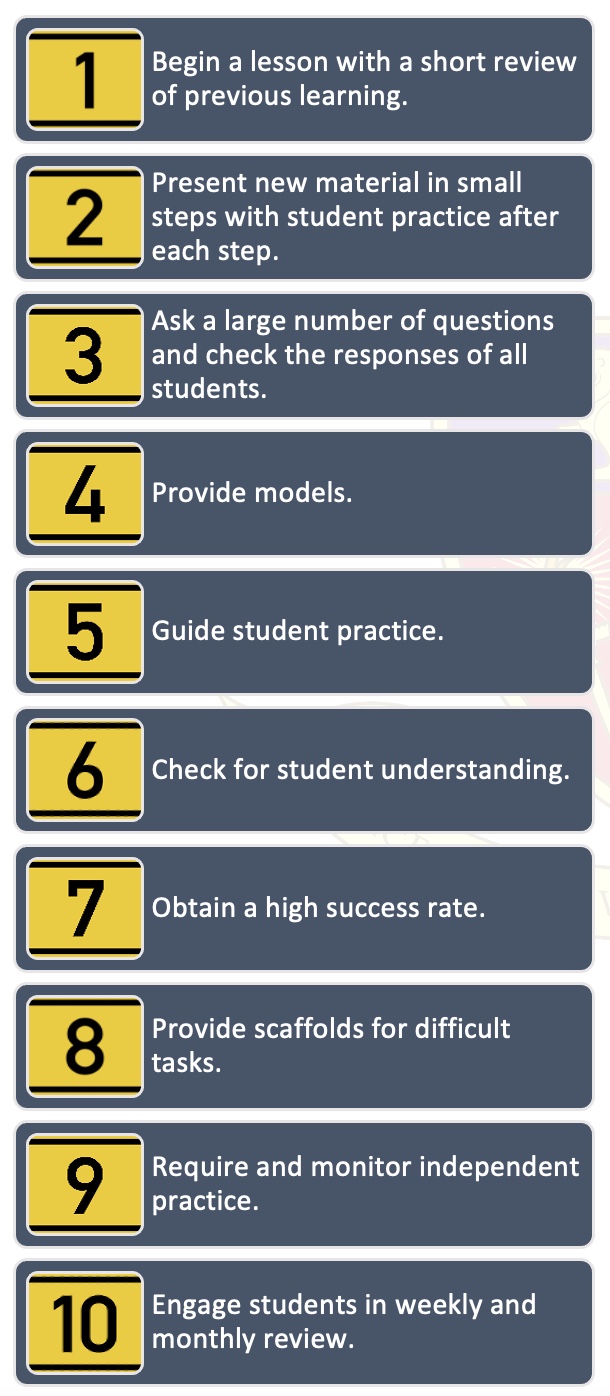
Figure 1 – Rosenhine’s Principles of Instruction
Natalija’s first steps were to outline the importance of spaced retrieval and how R1 (Rosenshine’s First Principle) was vital to the successful delivery to a sequence of lessons. By asking her teams to think about what, when and how short reviews of previous learning would take place; Natalija set the wheels in motion to improve the flow of lessons in the PRE curriculum. The next principles that she prioritised were R2 – 5 and R8.
When I asked Natalija why she chose to go through with this order, she explained that there was some good practice already embedded in the department. Hence, after evaluating the current impact of the delivery of their schemes of work, she decided to act on the evidence such that:
- R1: Content is there but needs to be reviewed effectively and in a timely manner to take into account for Ebbing’s Forgetting Curve and Spaced Retrieval. This could be a quick win with a large positive impact
- R2: Once the pupils are reviewing the relevant content, they can build upon their prior knowledge when covering new material, which assists with schema building. This is a process that can support encoding information into long term memory and enhances the ability to recall information.
- R3 – 5: Asking open questions within the PRE curriculum is good, but like all subjects, we need to think about how all pupils can have the opportunity to become involved in how that information is processed.
- R8: Differentiation is seen as a key part of expert teaching, but activities that develop skills or introduce new content need to be scaffolded appropriately. Pupils should be recalling and building upon prior knowledge. Then the scaffolding can truly live up to its label by being removed when pupils undergo guided practice to work towards mastery. This will also give R7 (High Success Rate).
Natalija explained how R7 played a huge part of her intent for the department. For pupils to develop an emotional attachment to their studies, they must also have some sense of progress. It is also important to not allow pupils to work independently for larger periods of time on errors, or else misconceptions may occur and demotivation may work against their levels of engagement.
In a brief meeting with Natalija recently, she explained how she intends to take her next steps in developing teaching and learning in PRE. Before viewing the ‘17 Principles of Effective Instruction’, or even before a more carful approach towards R6 or R9, Natalija wanted to model (R4) how one might teach a lesson, without explicitly linking the principles until the end.
By understanding the cognitive science behind Rosenshine’s Principles, Natalija truly modelled the potential impact that a department may have through research informed teaching and learning. She outlined her unique perspective on educators to provide more understanding behind her approach:
“I firmly believe that the most important duty of a teacher is to explicitly teach students how learning works. I demythologise learning processes by providing ideas, ways and schemes for moving information from working to short and ultimately long term memory.”
Some of the next steps she has planned for her department are to develop two knowledge tests per each scheme of work and to assure that pupils’ starter activities include either meaningful recall activities or strategies that prime pupils’ brains for the topic. Finally, through continuous reflective practice based on Bloom’s Taxonomy and Rosenshine’s POI, to assure that the main body of lessons have engaging tasks that enhance students’ love of learning.
“A good teacher can inspire hope, ignite the imagination, and instil a love of learning.”
Brad Henry
[1] Rosenshine, B. – Principles of Instruction: Research-Based Strategies That All Teachers Should Know, American Educator Vol. 36, No. 1, Spring 2012, AFT

June 2021 Edition

By Hetal Shukla
Share
Mind the Gap

The Challenge
Individuals are different, so are their learning abilities. High attaining students in England generally perform well when compared to their peers in other countries. However, one of the biggest challenge in our schools is to provide the right level of support that will help uplift the performance of the low attaining students. These students are unable to perform at the same level as their peers due to several factors e.g. poverty, special education needs, some aspects of ethnicity and other characteristics of vulnerability, which are further classified [Ref. 1] below as,
- Demographic Factors: Gender, socio-economic status, and parents’ educational level.
- Instructional Factors: teacher competency, instructional strategies and techniques, curriculum, school context and facilities
- Individual Factors: self-directed learning, arithmetic ability, motivation

A recent report by Education Policy Institute [Ref. 2], highlights the fact that that the attainment gap is no longer narrowing for the first time in a decade. The research in this report is pre-pandemic and statistics are looking worse due to impact of Covid 19 i.e. lockdown and loss of education. Highlights from the report:
- At secondary schools, by the time students take their GCSE, disadvantaged students are over 18.1 months of learning behind their peers
- The gap at primary schools is over 3 months of learning, which indicates that the gap widens further when they enter secondary education, and doubles in next 3 years (year 7, 8 and 9)
- Children with high persistence of poverty (on free school meals for 80% of their time in schools) are behind by 22.7 learning months i.e. almost 2 years behind
- Pupils with SEND, with EHCP, are well over 3 years behind and without EHCP are more than 2 years behind
- There is an obvious disparity between minority ethnic groups when compared to White British ethnic group
The research suggests that, at this rate, it will take us another 500 years to bring all students at the same level!
DfE has provided guidelines to help narrow the attainment gap [Ref.3]. The report Cracking the code: how schools can improve social mobility (DfE, 2014) [Ref. 4] goes further and states that effective use of student premium is only one piece of the jigsaw and outlines the importance of:
- building high expectations and an inclusive culture
- an incessant focus on quality early years teaching
- tailored strategies to engage parents
- preparing students for all aspects of life, not just exams
The teaching strategies deemed by schools to be most effective in increasing disadvantaged students’ attainment include:
- paired or small group additional teaching
- improving feedback to students
- one-to-one tuition
- provision of additional teachers or teaching
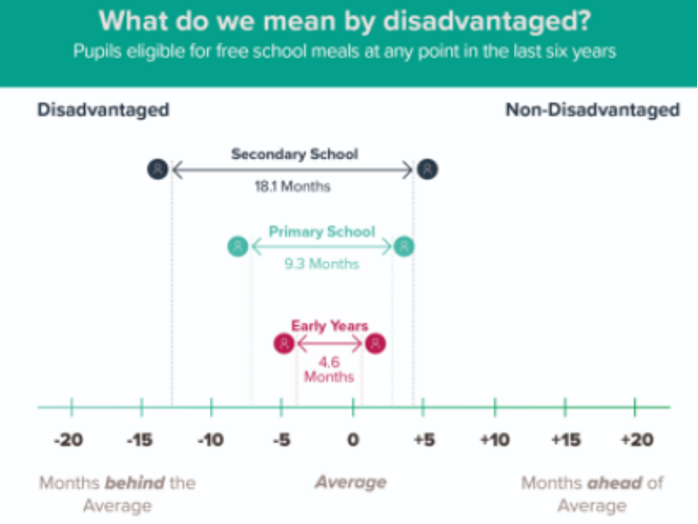
What can we do?
In my journey as a support teacher in Avanti Fields School (Leicester), I have been trying to understand students who struggle in obtaining, processing and retaining mathematical information in maths intervention classes. By learning more about them, understanding their mathematical abilities and the reasons for their shortcomings to cope up the concepts of maths, I have designed structured and tailored interventions to support individuals, which will help them in narrowing their attainment gap in Maths.

I have been using various techniques during maths intervention sessions. Some of the techniques involved are listed below:
- improving performance of the students by providing positive feedback i.e. reward rather than consequences
- using scaffolding strategies, instructional techniques, further enhancing student’s learning
- introducing maths concepts in Gujarati and Hindi to EAL students in their first language, making it easy for them to grasp technical concepts
- Using the strategy of, ‘I Do, We Do and You Do’, leading them to independent learning
- application and practical based learning rather than teaching mathematical methods
- using research-based CRA instruction (Concrete, Representational and Abstract sequence of instructions )
- providing tailored resources and homework befitting individual abilities
- Increasing curiosity and interest in the subject via building posters of historical known personalities in the subject.
- motivating them to do well by showing the end state
- creating an environment of fun using maths around usg. cutting a pizza, a tortilla or a chocolate bar to teach concept of Fraction
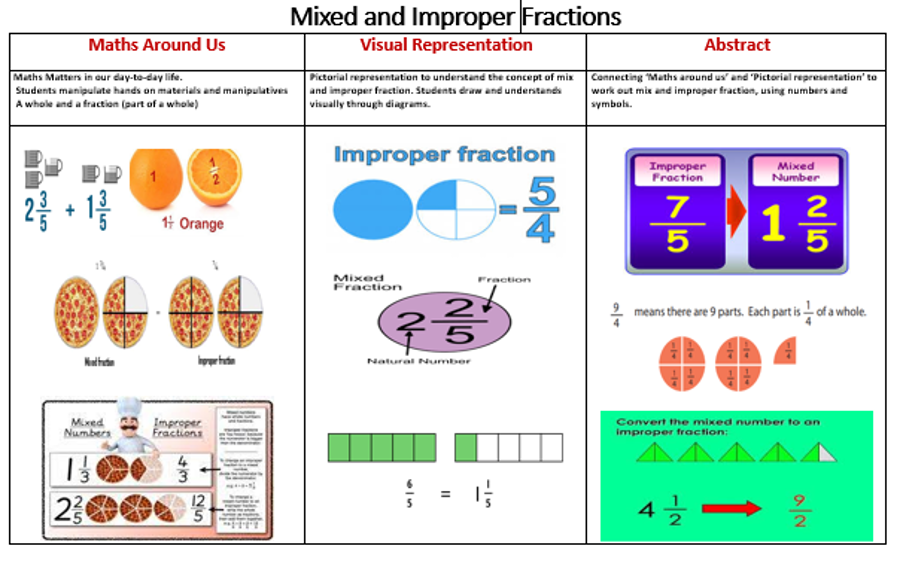
Concrete, Representational and Abstract (CRA) Instruction Model
An Intervention Framework for Mathematics has been designed and proposed, which is generic and can be used for other subjects as well. I have also been working on a tool to help estimate time required to raise the attainment levels via intervention. I have provided some excerpts here and further details can be provided on request, you can reach out to me on [email protected].
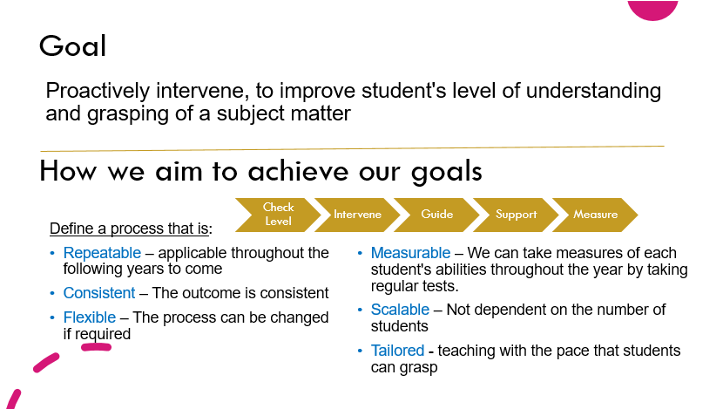
Intervention Framework – Workflow
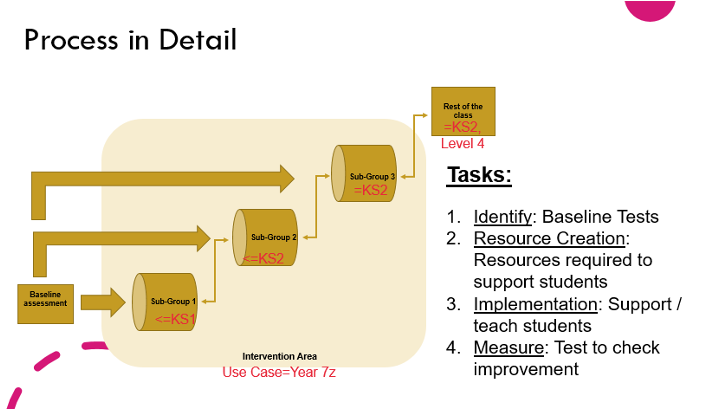
Intervention Framework – Levels and Group
Estimation Tool: (data is only for illustration purpose and is not actual)

Estimation Tool – Estimated Time Required for Intervention
By looking at the statistics available, we can definitely conclude that we need to take radical steps at the earliest to avoid further damage to the low achieving and underprivileged students.
With available research and guidelines from DfE and seeing the reality at first hand while executing intervention sessions as support teacher at AFS, I can confidently say that we can bring the change and reduce the gap by providing additional time and running special clinics e.g. mathematics. Allocating 25 min / week is not good enough for students of year 8 and 9, who are estimated to be behind by 18.1 learning months from their peers. The low achieving students need regular interventions on a one-to-one basis, paired, in-group and in class. We can massively reduce the gap by introducing maths concepts to them in their first language e.g. Gujarati or Hindi to speed up the learning process, which are difficult to understand otherwise. One-size-fits-all instructional strategies are not efficient for these low achieving students, as they require customised strategies. We should run targeted campaigns e.g. #LevelUpEducation within Avanti School Trust with a focus to help and uplift the levels of these students before we find it is too little, too late.
References:
1. Identifying Factors Affecting the Mathematics Achievement of Students for Better Instructional Design- Tuncay Saritas and Omur Akdemir, Turkey. http://itdl.org/Journal/Dec_09/article03.htm
2. Education in England: Annual Report 2020, produced by Education Policy Institute, https://epi.org.uk/wp-content/uploads/2020/09/EPI_2020_Annual_Report_.pdf
3. https://www.gov.uk/government/publications/supporting-the-attainment-of-disadvantaged-pupils
4. https://assets.publishing.service.gov.uk
/government/uploads/
system/uploads/attachment_data/file/360753/Cracking_the_code_Final.pdf
5. https://www.researchgate.net/publication/283026221_The_concrete-representational-abstract_sequence_of_instruction_in_mathematics_classrooms

June 2021 Edition

By Dravit Koorichh
Share
Leadership in Science
In May 2021, Avanti House Primary School was thrilled to be one of the 334 schools across the country to be awarded the nationally recognised Primary Science Quality Mark (PSQM) GILT award 2021.
In 2019, Avanti House Primary School decided to apply for the PSQM to align with their vision of helping each child become a well-rounded human being by giving them a holistic education through connections to the natural world and the community. Primary Science Quality Mark (PSQM) is the only national award scheme to develop and celebrate the quality of science teaching and learning in primary schools. Schools achieve a PSQM through a year-long process of initial audit, followed by action and evidenced-based reflection. Due to the global pandemic, a process which should have taken a year, took 18 months to finish.
The PSQM programme ensures effective leadership of science, enabling schools to work together to share good practice, supported by professional development led by local experts. It encourages teacher autonomy and innovation while at the same time offering a clear framework for development in science subject leadership, teaching and learning. Schools that achieve PSQM demonstrate commitment and expertise in science leadership, teaching and learning.
Associate Professor Jane Turner, PSQM National Director said: “There was never a more important time for primary children to have a high-quality science education. The Coronavirus Pandemic has made everyone aware of the impact of science on our daily lives. Primary schools have an important role to ensure that children understand how science works and keeps us healthy and safe. Schools that have achieved a Primary Science Quality Mark have demonstrated a significant commitment to science teaching and learning, even at this challenging time for schools. The profile and quality of science in each awarded school is very high. Children are engaging with great science both in and outside the classroom, developing positive attitudes towards science as well as secure scientific understanding and skills. Science subject leaders, their colleagues, head teachers, children, parents and governors should be very proud.”
Special recognition was paid towards Mrs Pant (whole school science lead) for placing ‘Science on the map’ for our community.

PSQM Evidence
The Science Lead at Avanti House Primary School made a portfolio of evidence to showcase some of the amazing scientific opportunities that the children at Avanti House Primary School have experienced throughout the last year! This is what Ed Walsh Senior Regional Hub Leader PSQM had to say –
‘Well done! It has been a very challenging time to prepare a PSQM submission, reflecting on the progress made using plans made in a different time. Your portfolio demonstrated a vibrant type of science and supported your reflections well. You have plans for future action and an honest style that demonstrates a professional approach that will ensure science continues to develop. Many congratulations to everyone at Avanti House, on all that has been achieved. This is well deserved.’
Here are some pictures of the PSQM portfolio submission:







June 2021 Edition

By Cherie Vincent
Share
PSHE and the Avanti Way Pupil Charter: Vision, Implementation, and Impact
Our Vision
‘Allow us to tell you what we are thinking or feeling. Whether our voices are big or small, whether we whisper or shout it, or paint, draw or mime it – listen to us and hear what we say.’ (Castle, 2000, Article 12)
The Avanti Way Pupil Charter has been designed for children, by children. Based on the 7 statements of the Avanti Way, it is a child-friendly document written by the PSHE Ambassadors of Avanti Court. This talented group of pupil leaders had a vision: they felt that the original statements should be re-imagined, enabling their peers to think about, act upon, and share the Avanti Way in words that they can interpret and explain.
The Charter is a powerful vehicle for pupil advocacy, placing children at the centre of decision-making that will impact their lives and how they are lived. Children learn best by example. Therefore, we must involve our whole school community to embed the language and reasoning so that children not only understand the Avanti Way, but choose it through their learning and behaviours. PSHE Ambassador Adithya (Year 6) explained:
‘Everyone is a learner at Avanti, including teachers, admin staff and parents. the Pupil Charter should be up in the main office, the staffroom, even the kitchen – then everyone can see it and follow the Avanti Way!’
Implementing the Avanti Way Pupil Charter:
The statements of the Charter are being embedded across the school one at a time. Our ambassadors are taking the lead on supporting children and staff in its implementation through our spiral, future proof PSHE Curriculum.
The work of Bruner (1960) introduced the concept of a spiral curriculum, which has two important features: firstly, the repetition and practising of skills already learned, and secondly, the ‘continual deepening and broadening’ of knowledge. (Bruner 1960, p 330). A spiral curriculum supports the full potential of the child, who like a curve, advances to higher levels through upward, expansive, and limitless learning experiences. We must consider that PSHE skills should be part of – not separate to – every aspect of a child’s life and daily experience, and structure our curriculum accordingly. The Avanti Way pupil charter is essential to this process because it is a tangible way to connect children with our three drivers: Educational Excellence, Character Formation and Spiritual Insight. With the help of the Charter, we can combine the systematic teaching of skills and competencies with plenty of rich opportunities for children to apply them every day: in the playground, lunch hall, in their homes, communities and beyond. This will ensure pupils are engaged in meaningful, purposeful learning that meets their needs now, as well as future-proof learning that will still be relevant in 10, 20 years and 50 years’ time. (Hughes, 2019 p55-61)
Impact: The Journey Continues:
The first statement, known as ‘Avanti Way 1’, is now fully embedded and its impact can be seen through children’s written and spoken outcomes. What is so striking is the self-awareness pupils are showing when self-regulating their feelings and behaviour. They apply high quality vocabulary to explain why values-based skills and strategies are relevant to their lives and future, and crucially, they reflect on how they can use them to help others:
‘Avanti Way 1 is about having high expectations for myself, which means I can be a role-model to others. I take responsibility for my own behaviour because others are always watching and learning from me – at school, at home and wherever I go.’ (Sawoni, Year 6)
‘Avanti Way 1 is about owning my own learning: to persevere, to push myself to reach my goals, and to achieve a better style of living which I can share with others. That is how I know I will be ready for secondary school.’
(Rowan, Year 6)
The Avanti Way Pupil Charter is another tool in our armour that we can use to develop an internal moral compass within our children. If we support children’s understanding of the seven statements, they will be better equipped to choose the Avanti Way, which will anchor them in our changing world and help to keep them safe throughout their lives. We know that life can be unpredictable and whilst we cannot control the kinds of situations our children will face, we can empower them to respond positively, to choose wisely, and to turn towards the light in all they do.
